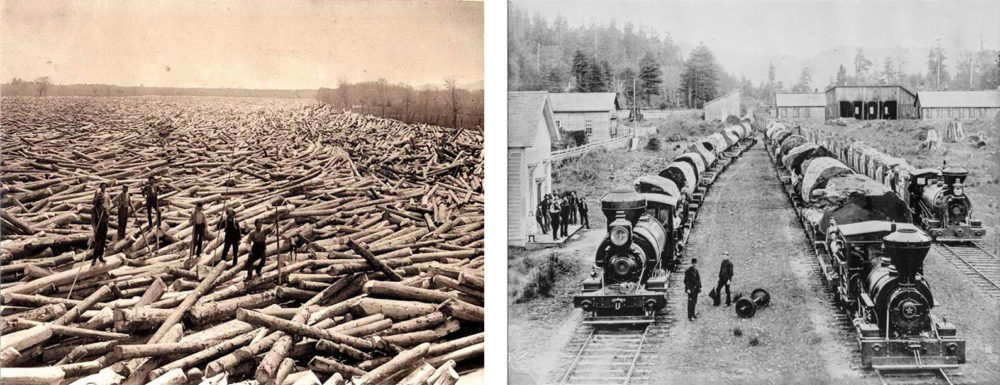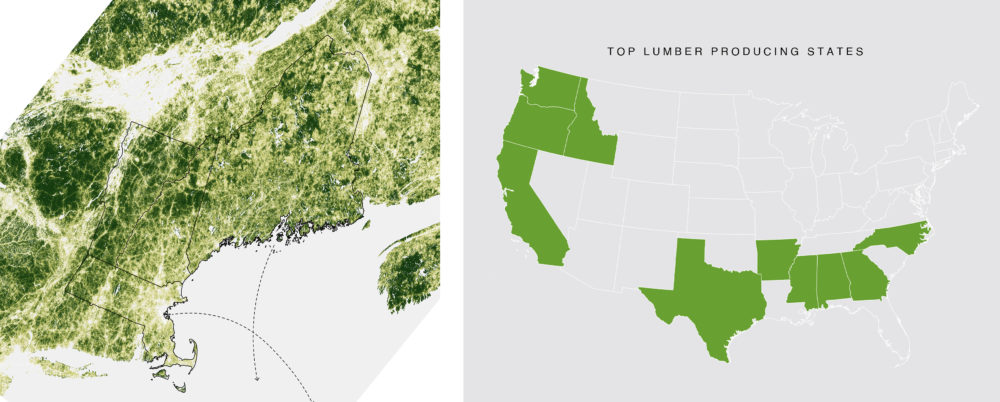History of the Lumber Industry in North America
The North American logging industry effectively began as soon as the first colonists founded Jamestown in 1607. English forests had been decimated as early as the thirteenth century in part from demand for ship construction and firewood to support a growing population.1 Beginning under the First Charter of Virginia issued by King James I, England used America’s natural wood resources as a new vital supply for their lumber industry, establishing an export economy that continued to expand until the Revolutionary War.
By the 1790s, the newly-formed United States was exporting more than 36 million feet of pine boards and 300 ship masts annually, with 75% coming from Massachusetts and Maine and another 20% from New Hampshire. By 1830 Bangor, Maine had become the world’s largest port for lumber exports, moving 8.7 billion feet of board over a 60-year time period. This insatiable demand for resources resulted in the rapid decimation of old-growth forests, forcing the industry west. The expansion of the rail network across the continent throughout the 19th century enabled further industry-spurred rapid deforestation.2
By 1900, timber supplies were dwindling in the upper Midwest, and so loggers looked to the Pacific Northwest. In 1899, Idaho produced 65 million board feet of lumber; by 1910 it produced 745 million.3 By 1920, the United States was producing around 35 billion square feet of lumber with the Pacific Northwest producing around 30 percent of that total. 4

The Great Depression hit the lumber industry hard with production falling to just 10 billion board feet in 1932. By 1950 production had rebounded to 38 billion feet of lumber and remained relatively constant until 1970.
From its inception, logging in the US was enmeshed within capitalist modes of extraction and colonialism. For workers in the field, the job was dangerous and grueling. Despite these negative aspects of its history, the heroic fables of Paul Bunyan emerged, romanticizing the hardships endured by workers over the centuries, ultimately celebrating the widespread deforestation and habitat loss as a feat of modernity. In reality, it was destructive to the environment and to the communities within which it took place, a fact that is still struggling to be rectified.
Today the US and Canada have some of the most stringent forest sustainability regulations in the world as well as sustainable forest industry practices.5 At the same time the two countries are among the world’s top forest product producers. Annual production in the US in 2020 was more than 30 billion board feet – almost $300 million in sales – making the US the largest producer and consumer of lumber globally,6 and generating more than 950,000 jobs domestically.7

- 1 “England's Forests: A Brief History of Trees.” The Guardian. Guardian News and Media, July 26, 2013. https://www.theguardian...
- 2 Pisani, D. (1985). Forests and Conservation, 1865-1890. <em>The Journal of American History, </em>Vol. 72, No. 2, pp. 340-359.
- 3 “Timber Industry.” Logging in the Northwest. Accessed March 17, 2023. http://www.cotf.edu...
- 4 Marchak, M. P. Logging the globe. Montreal & Kingston, Jamaica: McGill-Queen's University Press, 1995. p. 56
- 5 “MODULE 1: RESPONSIBLE FOREST MANAGEMENT IN U.S. AND CANADA.” GreenBlue. Accessed March 17, 2023. https://greenblue.org...
- 6 Alderman, Delton. “United States Forest Products Annual Market Review and Prospects, 2015-2021.” Forest Products Laboratory, October 2020.
- 7 “Forest Products.” US Forest Service Research and Development. Accessed February 23, 2023. https://www.fs.usda.gov...